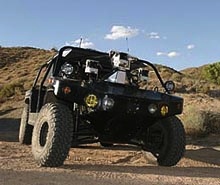Cornell vehicle will try to drive 175 miles of rough terrain without human control
A challenge: Build a car that can drive itself.
Offroad!

The DARPA Challenge: Build a car that can drive itself across 175 miles of desert with unpaved roads, ditches, berms, sandy ground, standing water, rocks and boulders, narrow underpasses, construction equipment, concrete safety rails, power line towers, barbed wire fences, cattle guards and maybe even tank traps.
Impossible? Probably. But a team of Cornell engineering students is in California trying, as contestants in the 2005 DARPA Challenge. They suspect they won't succeed, but they don't think anyone else will either. In last year's competition, the most successful car only went 7.5 miles before breaking down.
Don’t forget! DARPA spawned the Internet.
It's an event that has "wait till next year!" built in, according to Matt Grimm '06, leader of the business team that supports the engineers. DARPA (the Defense Advanced Research Projects Administration) has offered a $2 million prize for the builders of the vehicle that can complete the course in the shortest time (with a 10-hour maximum). The goal is to create autonomous vehicles that can transport supplies or perform reconnaissance in dangerous places -- like Iraqi highways -- without endangering troops. Beyond that, the technology has applications in disaster response and space exploration. By making the task hard enough to require several years of trial and error, Grimm said, DARPA will get thoroughly tested ideas. But, he adds, Cornell is going in with a design that could succeed.
------------
The course will start and end in Primm, Nev., about 50 miles south of Las Vegas on the California-Nevada border, but DARPA will not reveal the route until the beginning of the test. Then, each team will be given a CD with the route laid out as a series of waypoints identified by latitude and longitude, precise down to 15 centimeters. The vehicle must figure out for itself how to get from one waypoint to the next, avoiding natural and man-made obstacles. The only command the team is allowed to give the vehicle is "start."
The Cornell team started with one of the most rugged off-road vehicles available, a Spider Light Strike Vehicle, manufactured and donated by Singapore Technologies. The all-terrain vehicle is built to military specifications and tested in combat, so it is much better able to cope with off-road conditions than an ordinary SUV or truck. The team figures that even if their sophisticated control system can't avoid an obstacle, the Spider might just be able to drive over it.
------------
In order to complete the course in 10 hours, the vehicle will have to average 17.5 mph. But since it may spend part of its journey moving very slowly over rough terrain, it will sometimes have to hit 35 to 40 mph.
And it gets Geeks to go outdoors!
Posted: Tue - September 27, 2005 at 05:27 PM